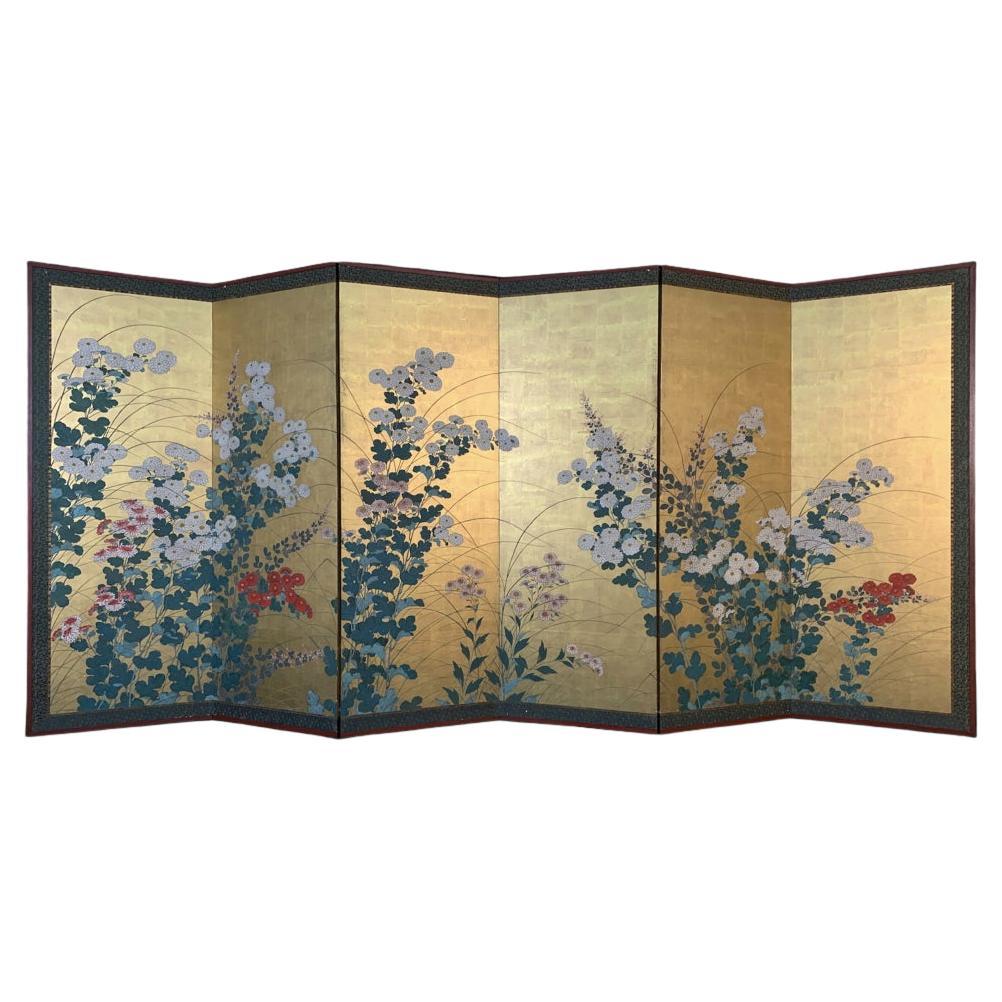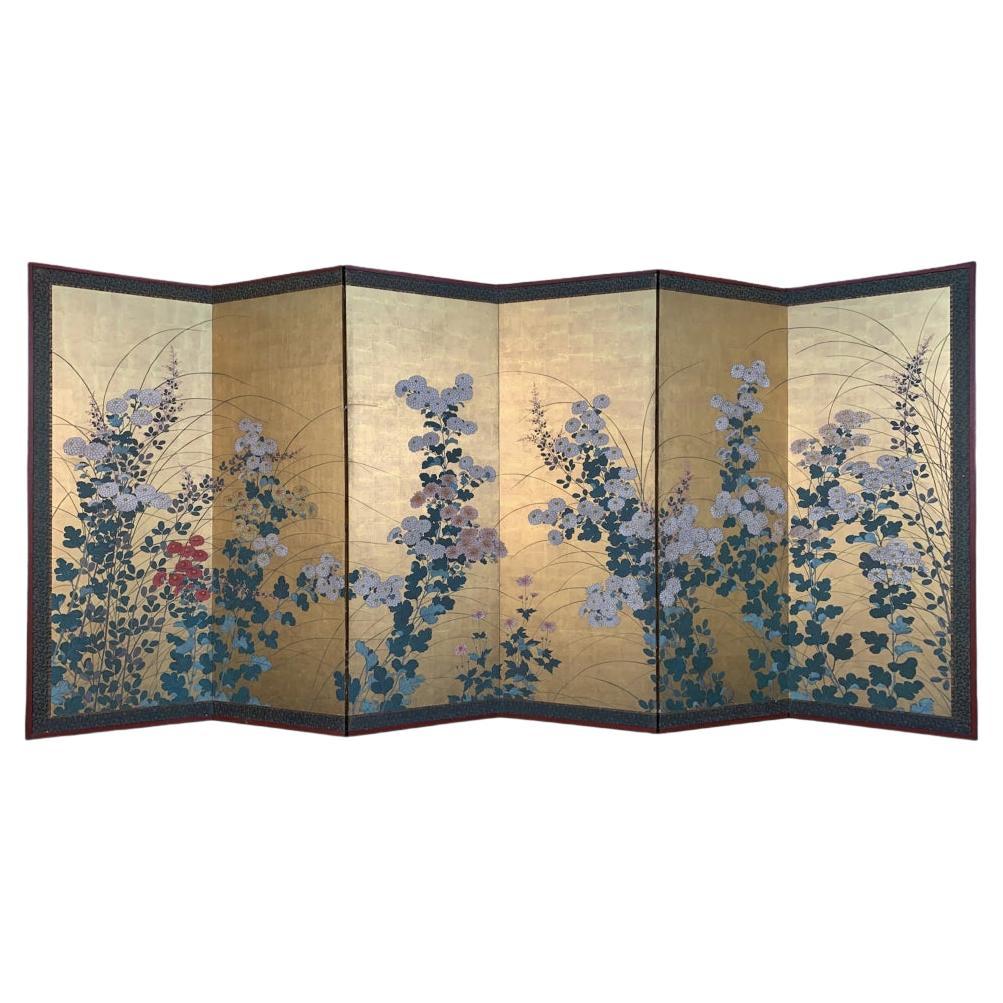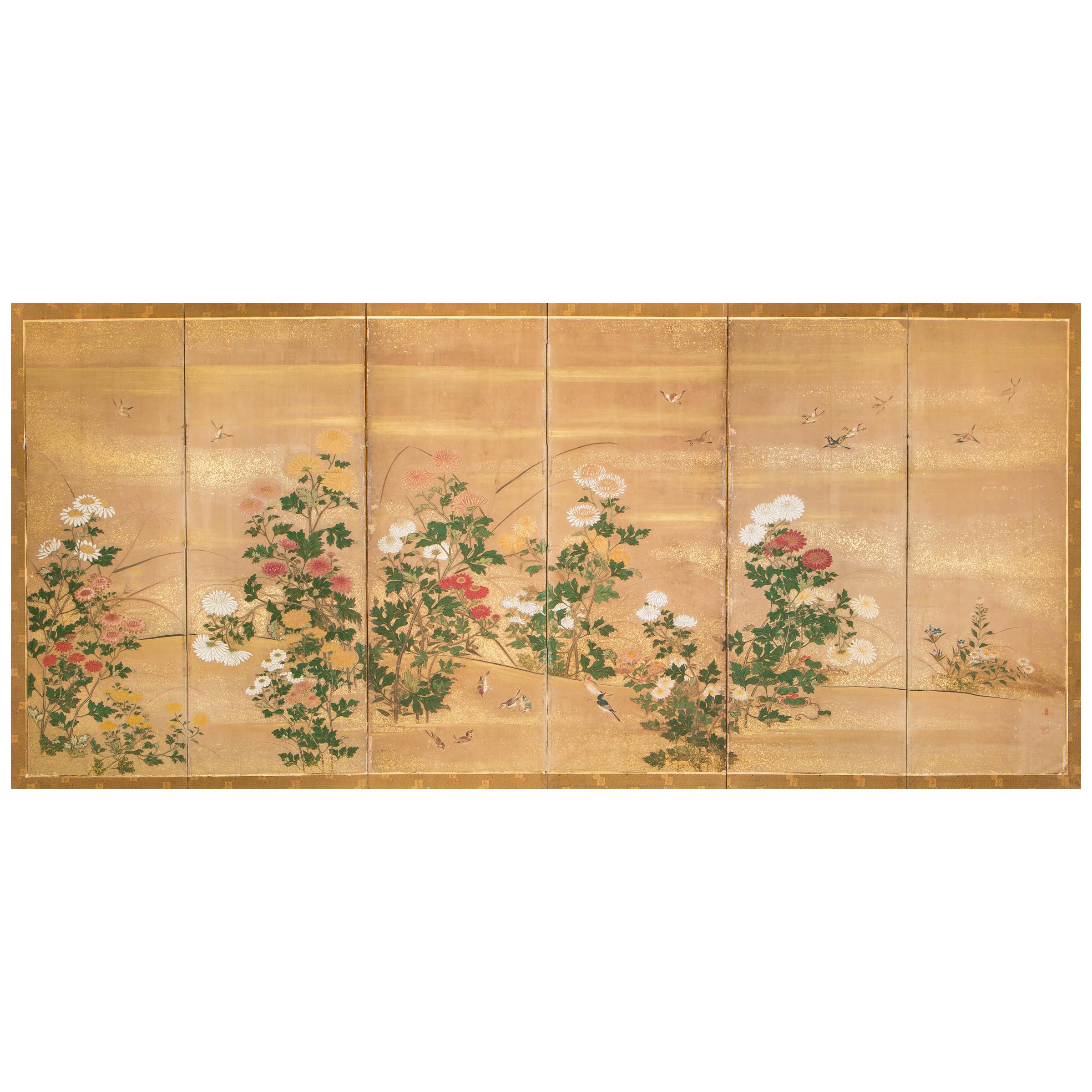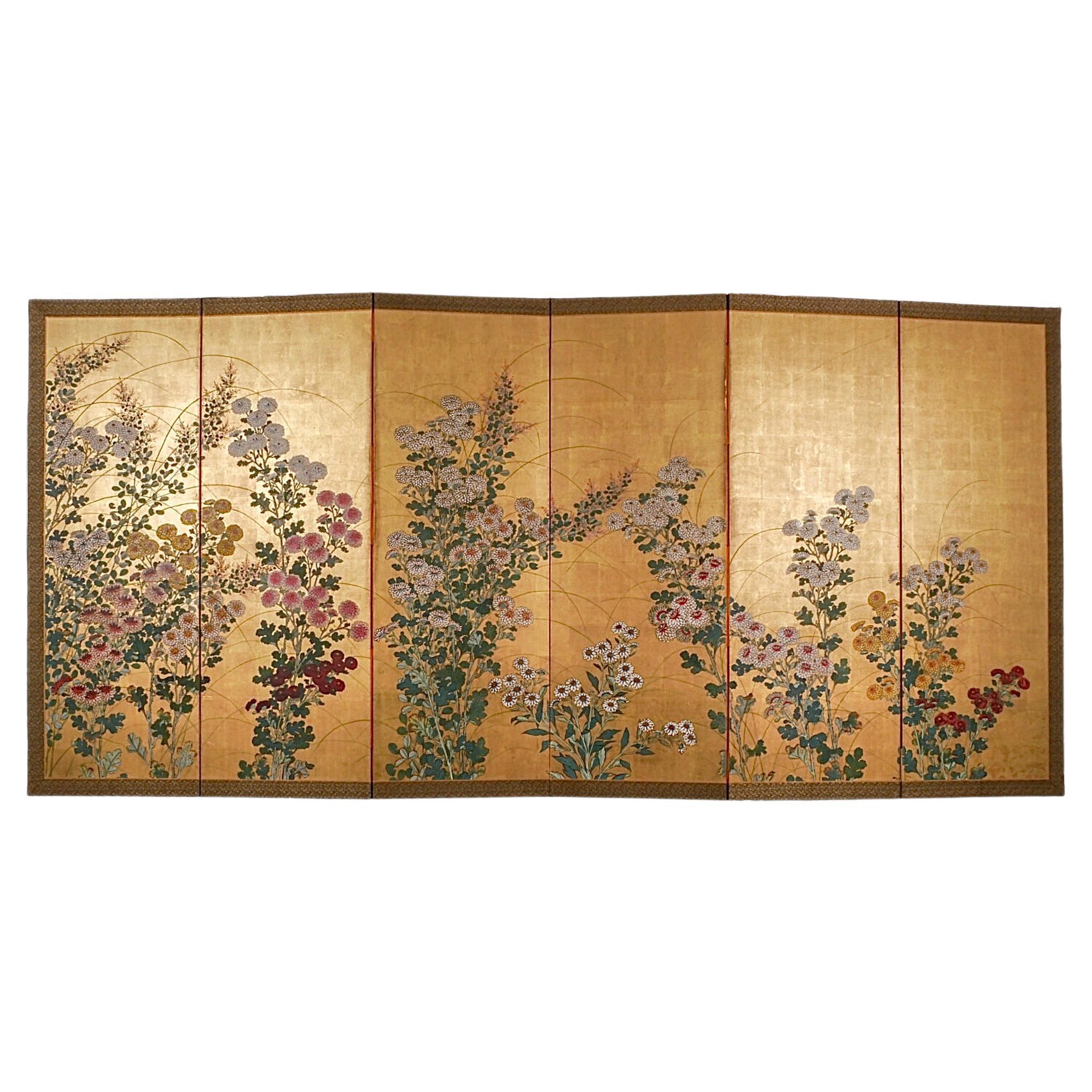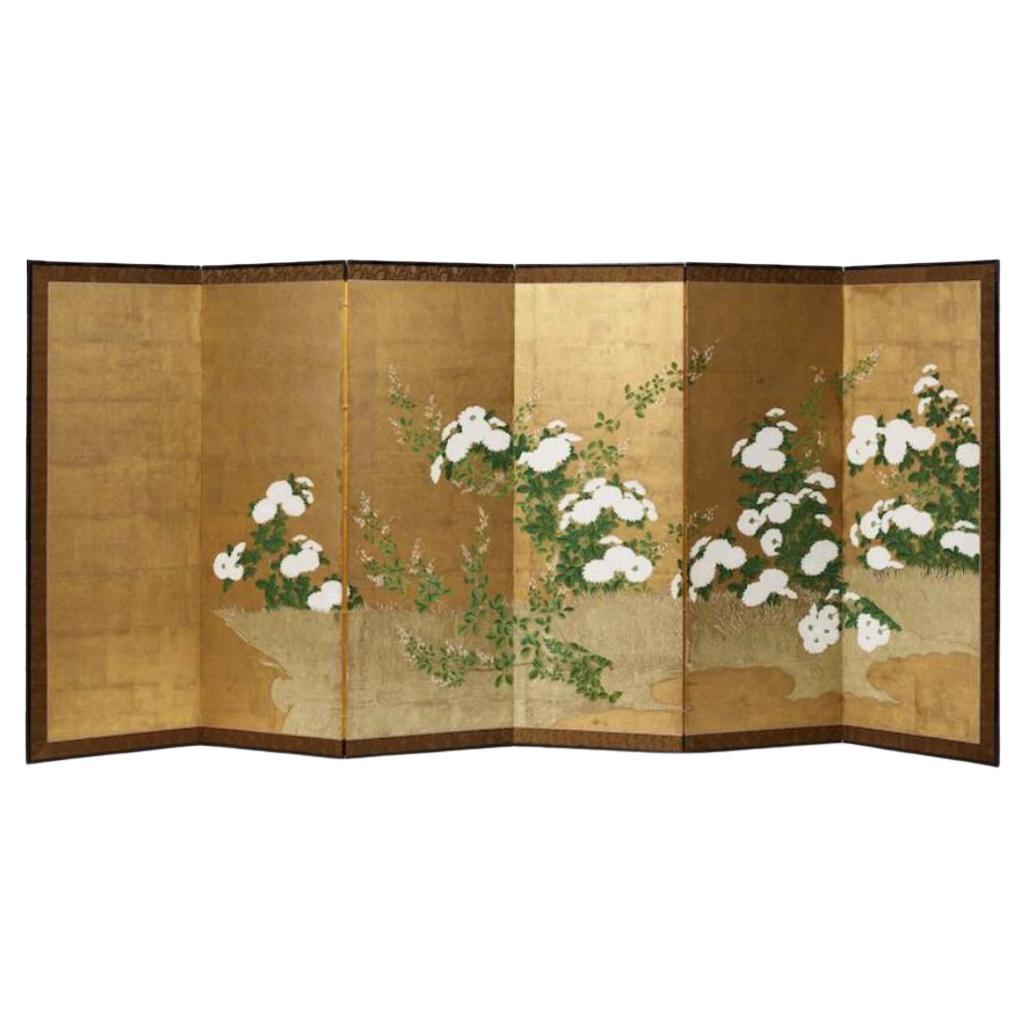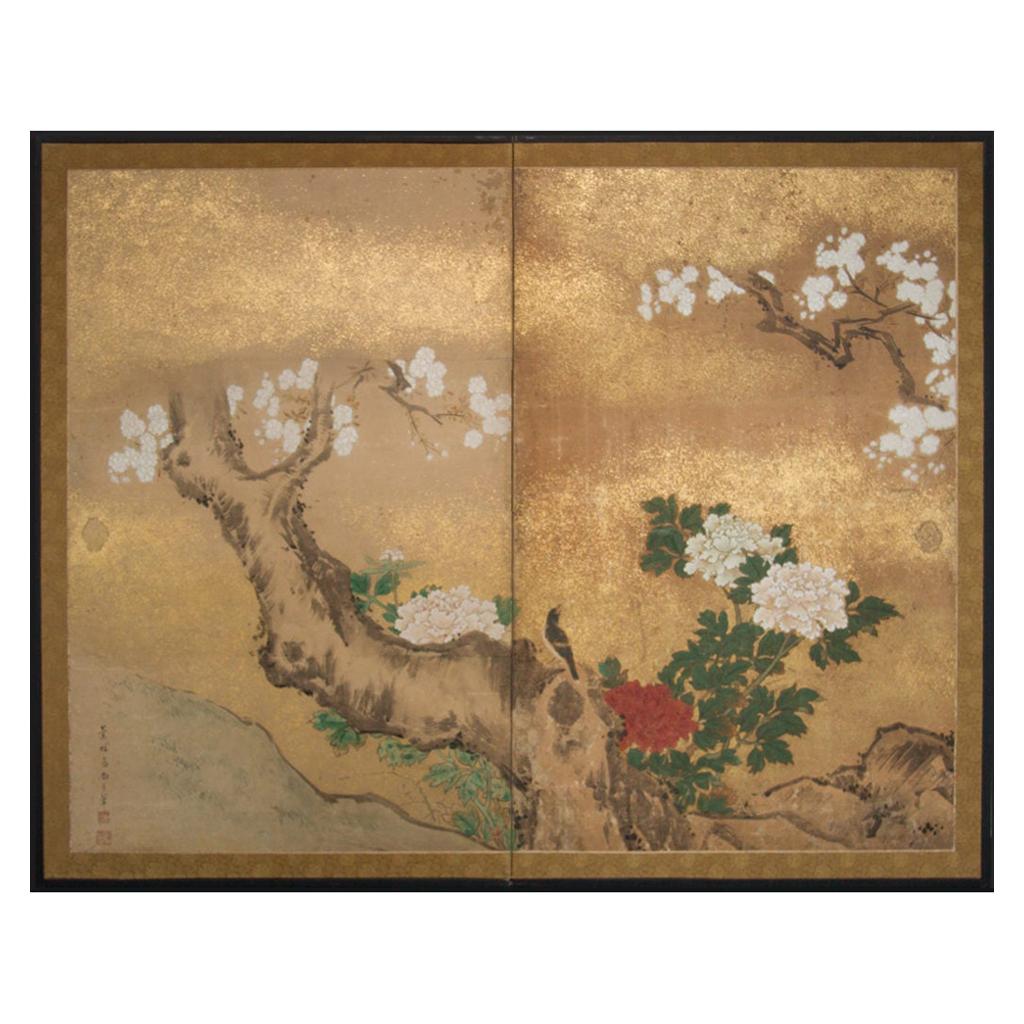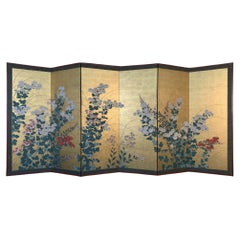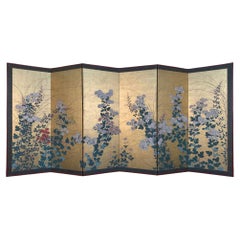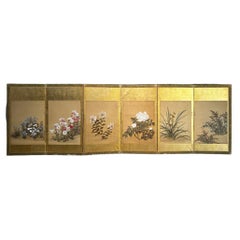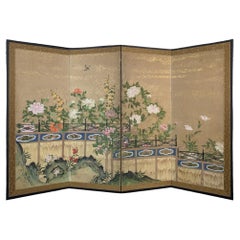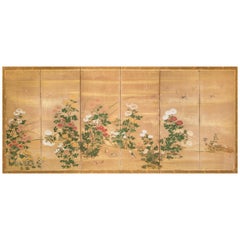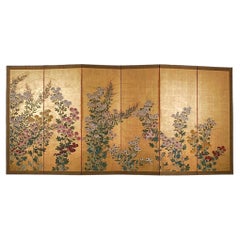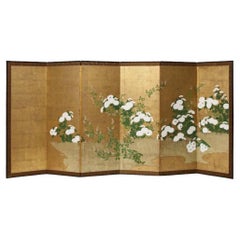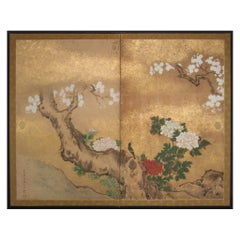Items Similar to Late Edo Period Rinpa School Chrysanthemum Blossom Screen
Video Loading
Want more images or videos?
Request additional images or videos from the seller
1 of 8
Late Edo Period Rinpa School Chrysanthemum Blossom Screen
$9,576
£7,321.36
€8,432.73
CA$13,418.91
A$14,980.95
CHF 7,849.79
MX$183,381.57
NOK 99,692.47
SEK 93,997.34
DKK 62,934.33
Shipping
Retrieving quote...The 1stDibs Promise:
Authenticity Guarantee,
Money-Back Guarantee,
24-Hour Cancellation
About the Item
Late Edo Period Rinpa School Chrysanthemum Blossom Screen
Period: late Edo, early 19th century
Size: 364 x 172 cm (143 x 67 inches)
SKU: PTA13
This exquisite late Edo period Rinpa school screen showcases lush chrysanthemum branches in full bloom, flourishing within their natural setting. Painted with vibrant colors, the chrysanthemum blossoms are captured in exquisite detail, enveloping the scene with an aura of beauty and elegance.
The Rinpa school, a prominent Japanese art movement that thrived throughout the Edo period (1603-1868), gained recognition for its bold hues, elaborate designs, and idealized depictions of nature. This screen beautifully exemplifies the Rinpa style, serving as a testament to the remarkable skill and artistic prowess of its creator.
Elevate your space with this unique screen – a captivating conversation starter and a prized collectible.
- Creator:Rimpa School (Artist)
- Dimensions:Height: 67.72 in (172 cm)Width: 143.31 in (364 cm)Depth: 0.79 in (2 cm)
- Style:Edo (Of the Period)
- Materials and Techniques:
- Place of Origin:
- Period:
- Date of Manufacture:unknown
- Condition:Minor losses. Condition report upon request.
- Seller Location:Fukuoka, JP
- Reference Number:1stDibs: LU8121238988202
About the Seller
5.0
Vetted Professional Seller
Every seller passes strict standards for authenticity and reliability
Established in 1998
1stDibs seller since 2023
57 sales on 1stDibs
Typical response time: <1 hour
- ShippingRetrieving quote...Shipping from: Tambon Hang Dong, Thailand
- Return Policy
Authenticity Guarantee
In the unlikely event there’s an issue with an item’s authenticity, contact us within 1 year for a full refund. DetailsMoney-Back Guarantee
If your item is not as described, is damaged in transit, or does not arrive, contact us within 7 days for a full refund. Details24-Hour Cancellation
You have a 24-hour grace period in which to reconsider your purchase, with no questions asked.Vetted Professional Sellers
Our world-class sellers must adhere to strict standards for service and quality, maintaining the integrity of our listings.Price-Match Guarantee
If you find that a seller listed the same item for a lower price elsewhere, we’ll match it.Trusted Global Delivery
Our best-in-class carrier network provides specialized shipping options worldwide, including custom delivery.More From This Seller
View AllEarly 19th Century Rimpa School Floral Screen
By Rimpa School
Located in Fukuoka, JP
Early 19th Century Rimpa School Floral Screen
Period: Early 19th Century
Dimensions: 367x171 cm (144.5x67.3 inches)
SKU: RJ118
This 6-panel gold-leafed screen is a splendid represe...
Category
Antique Early 19th Century Japanese Edo Paintings and Screens
Materials
Gold Leaf
Early 19th Century Rimpa School Floral Screen
By Rimpa School
Located in Fukuoka, JP
Early 19th Century Rimpa School Floral Screen
Period: Early 19th Century
Dimensions: 367x171 cm (144.5x67.3 inches)
SKU: RJ118/2
This 6-panel gold-leafed screen is a splendid repre...
Category
Antique Early 19th Century Japanese Edo Paintings and Screens
Materials
Gold Leaf
Edo Period Rimpa School Golden Screen - Summer Florals
By Rimpa School
Located in Fukuoka, JP
Edo Period Golden Screen - Summer Florals
Period: Edo
Size: 285 x 92.5 cm (112.2 x 36.4 inches)
SKU: PTA141
This Edo period screen is a golden-framed window into the summer gardens...
Category
Antique 18th Century Japanese Edo Paintings and Screens
Materials
Gold Leaf
Peony Blossoms Screen
Located in Fukuoka, JP
Peony Blossoms Screen
Period: Edo period 18-19th century
Size: 212 x 138 cm (83.5 x 54.3 inches)
SKU: PJ105
Experience a rare gem from Japan's heritage – an Edo period peony blosso...
Category
Antique 18th Century Japanese Edo Paintings and Screens
Materials
Silk, Paper
Edo Period Seasonal Transition Screen
Located in Fukuoka, JP
Edo Period Seasonal Transition Screen
Period: Edo
Size: 368 x 153 cm
SKU: PTA148
This exquisite six-panel screen, adorned with golden flakes, beautifully portrays the seamles...
Category
Antique 19th Century Japanese Edo Paintings and Screens
Materials
Gold Leaf
Meiji Chrysanthemum Masterpiece
Located in Fukuoka, JP
Step into a world of timeless beauty with our exceptional six-panel screen from the Edo-Meiji period. In impeccable condition, each panel features stunning paintings of chrysanthemum...
Category
Antique 19th Century Japanese Meiji Paintings and Screens
Materials
Gold
You May Also Like
Japanese Six-Panel Screen, Chrysanthemums
Located in Hudson, NY
Japanese six-panel screen: Chrysanthemums, Edo period (circa 1800) painting of a variety of chrysanthemums in a garden landscape, with sparrows. Mineral p...
Category
Antique Early 1800s Japanese Edo Paintings and Screens
Materials
Gold Leaf
Japanese Six-Panel Screen Byobu With Chrysanthemums And Autumn Grass and Flower
Located in Torino, IT
The 19th Century Six-Panel Japanese folding screen "Byōbu" usually used in the most important Japanese house to stop wind and also to separate different space of the same big room de...
Category
Antique Mid-19th Century Japanese Edo Paintings and Screens
Materials
Gold Leaf
Kiku to Hagi Byobu, Rinpa School Style, Edo Period.
Located in Point Richmond, CA
A Chrysanthemum and Bush Clover painting on gold leaf six-panel folding screen, painted with clusters of leafy green chrysanthemum plants with white blossoms having moriage relief petals of gofun growing amidst pink blossoming bush clover within a bunched bush clover garden fence rendered in lighter gold relief, all on a background entirely of rich gold leaf. These two flowers are symbolic of Japan and the autumn season. The classic patterned paper verso with a Naga Antiques...
Category
Antique Early 1800s Japanese Edo Paintings and Screens
Materials
Gold Leaf
Japanese Two-Panel Screen Peony and Cherry
Located in Hudson, NY
Japanese two-panel screen: Peony and Cherry, Edo period (circa 1800) painting, formerly fusuma (Japanese sliding doors), executed in the Kano school style, featuring a cherry tree in...
Category
Antique Early 1800s Japanese Edo Paintings and Screens
Materials
Gold Leaf
Japanese Six-Panel Screen, Rimpa School Chrysanthemums on Gold
Located in Hudson, NY
An abundant use of gold with beautifully draped chrysanthemums and gold flake clouds. Mineral pigments, go fun, gold leaf on mulberry paper with a silk brocade border.
Category
Antique Early 19th Century Japanese Meiji Paintings and Screens
Materials
Gold Leaf
Japanese Edo Period Two-Panel Screen with Chrysanthemums
Located in New York, NY
Japanese set of sliding doors that have been mounted as a screen in the early 20th century and the panels from the 19th-century.
ABOUT
This screen is indeed a masterpiece o...
Category
Antique 19th Century Japanese Japonisme Paintings and Screens
Materials
Wood
More Ways To Browse
Used School Furniture
Antique Chrysanthemum
Chrysanthemum Painting
Japanese Edo Period Screens
18th Century Japanese Screens
Japanese Screen Chrysanthemums
Japanese Rimpa Screens
Japanese Screen Rinpa
Rinpa School
Japanese Insect
Chinese Lattice
Antique Hand Painted Japanese China
Japanese Silk Painting 20th Century
Japanese Crane Art
Japanese Folding Screens
Silk Japanese Scrolls
Chinese Bird Painting
Japanese Gold Leaf Panel Paintings
